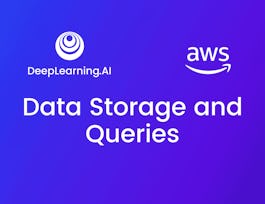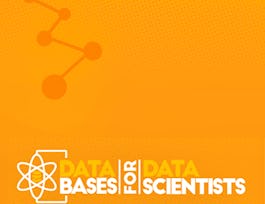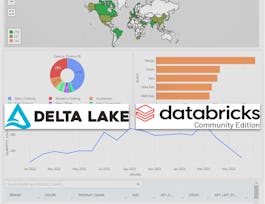This is the second course in our Specialization in Teradata and Data Analysis. In the first course, we set up the concepts, principles, and practical basics to install software, load data, and design a logical and physical data model. In this second course, we'll improve our techniques for data analysis, with an eye on efficiency and storage for your real-world applications on the job.

Offrez à votre carrière le cadeau de Coursera Plus avec $160 de réduction, facturé annuellement. Économisez aujourd’hui.


Teradata: Improving Analysis and Storage
Ce cours fait partie de Spécialisation Data Analytics with Teradata

Instructeur : Eric Grose
Inclus avec 
Expérience recommandée
Ce que vous apprendrez
Single-Row and Multiple-Row subqueries in Teradata
Use of Aggregate Functions and JOINs in Teradata
Advanced SQL Techniques - Windowed Functions, Hierarchical Queries, and Indexes
Compétences que vous acquerrez
- Catégorie : Teradata SQL
- Catégorie : Teradata BI
Détails à connaître

Ajouter à votre profil LinkedIn
juillet 2024
11 devoirs
Découvrez comment les employés des entreprises prestigieuses maîtrisent des compétences recherchées

Élaborez votre expertise du sujet
- Apprenez de nouveaux concepts auprès d'experts du secteur
- Acquérez une compréhension de base d'un sujet ou d'un outil
- Développez des compétences professionnelles avec des projets pratiques
- Obtenez un certificat professionnel partageable


Obtenez un certificat professionnel
Ajoutez cette qualification à votre profil LinkedIn ou à votre CV
Partagez-le sur les réseaux sociaux et dans votre évaluation de performance

Il y a 3 modules dans ce cours
In this first module, we’ll look at effective requirements gathering, the use of aggregate functions, and the principles of normalization to refine our SQL querying skills. To make more valuable SQL queries, our first step is requirements gathering. Requirements Gathering involves detailed specifications about the data's format, quality, and sources. You’ll learn to prioritize data based on potential impact and engage stakeholders to help uncover essential, sometimes hidden, requirements. You will learn the most common aggregate functions available in Teradata: SUM, AVG, MAX, and COUNT. We’ll examine when we would typically use these functions, and how the output of these functions is different from traditional SQL queries. We’ll take a closer look at three levels of data normalization. Normalization reduces redundancy and ensures that each piece of data is stored precisely once, linked directly to a primary key. Finally, we’ll use SQL joins to link data across multiple tables. Using Inner Joins and left Joins which help us tailor our queries to meet specific analytical needs.
Inclus
14 vidéos4 lectures4 devoirs1 sujet de discussion2 plugins
In this module, we will practice some practical applications of SQL subqueries, focusing on both single-row and multiple-row subqueries to enhance your data analysis skills. We'll start by exploring single-row subqueries, an advanced SQL technique perfect for conducting precise data checks within larger queries. You'll learn how to structure these subqueries to compare specific values against results returned by another query, which is crucial for tasks such as verifying if inventory levels meet demand or if a customer's purchase exceeds the average. Following that, we will examine multiple-row subqueries, which allow you to compare a value against multiple values returned from a subquery. This session will cover how to use SQL operators like IN, ANY, or ALL to filter and analyze data effectively. Through detailed examples and structured queries, this module will equip you with the knowledge to apply these techniques directly to real-world business intelligence scenarios, enhancing both the specificity and relevance of your data analysis.
Inclus
6 vidéos3 lectures3 devoirs1 sujet de discussion1 plugin
This module introduces key SQL concepts and techniques to enhance data analysis using Teradata. Window functions enable advanced data aggregation over specified ranges, allowing for dynamic time-based evaluations and facilitating calculations such as running totals, moving averages, and lagging or leading values. Hierarchical queries provide a framework for analyzing parent-child relationships within data, crucial for understanding complex structures like supply chains. This module covers the syntax and practical applications of these queries, highlighting their use in organizing and analyzing hierarchical data effectively. Finally, the module explains the importance of indexes in SQL for quicker data retrieval. Indexes prioritize frequently accessed columns, enhancing query performance and ensuring efficient data processing. These concepts collectively equip data analysts with robust tools for sophisticated data analysis and strategic decision-making.
Inclus
11 vidéos2 lectures4 devoirs1 sujet de discussion
Instructeur

Offert par
Recommandé si vous êtes intéressé(e) par Data Analysis

DeepLearning.AI

University of Colorado Boulder

Coursera Project Network
Pour quelles raisons les étudiants sur Coursera nous choisissent-ils pour leur carrière ?





Ouvrez de nouvelles portes avec Coursera Plus
Accès illimité à plus de 7 000 cours de renommée internationale, à des projets pratiques et à des programmes de certificats reconnus sur le marché du travail, tous inclus dans votre abonnement
Faites progresser votre carrière avec un diplôme en ligne
Obtenez un diplôme auprès d’universités de renommée mondiale - 100 % en ligne
Rejoignez plus de 3 400 entreprises mondiales qui ont choisi Coursera pour les affaires
Améliorez les compétences de vos employés pour exceller dans l’économie numérique
Foire Aux Questions
Access to lectures and assignments depends on your type of enrollment. If you take a course in audit mode, you will be able to see most course materials for free. To access graded assignments and to earn a Certificate, you will need to purchase the Certificate experience, during or after your audit. If you don't see the audit option:
The course may not offer an audit option. You can try a Free Trial instead, or apply for Financial Aid.
The course may offer 'Full Course, No Certificate' instead. This option lets you see all course materials, submit required assessments, and get a final grade. This also means that you will not be able to purchase a Certificate experience.
When you enroll in the course, you get access to all of the courses in the Specialization, and you earn a certificate when you complete the work. Your electronic Certificate will be added to your Accomplishments page - from there, you can print your Certificate or add it to your LinkedIn profile. If you only want to read and view the course content, you can audit the course for free.
If you subscribed, you get a 7-day free trial during which you can cancel at no penalty. After that, we don’t give refunds, but you can cancel your subscription at any time. See our full refund policy.


